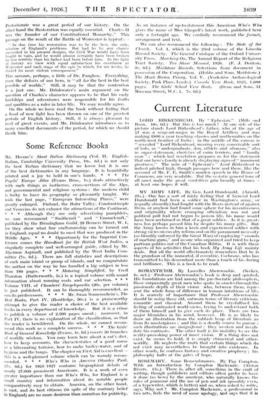Some Reference Books
Ma. HoanE's Short Italian. Dictionary (Vol. II. English- Italian, Cambridge University Press, 10s. 6d.) is not only the best Italian dictionary that we know but it is one of the best dictionaries in any language. It is beautifully printed and a joy to hold in one's hands. * * * The Pupils' Europe Atlas (Evans Bros., ls.) deals attractively with such things as isotherms, cross-sections of the Alps, and governmental and religious systems : the modern child is lucky to have its geography so pleasantly taught. We wish the last page, " European Interesting Places," were greatly' enlarged.' Finland, the Ruhr Valley. Constantinople and Vesuvius do not exhaust the attractions of the Continent. * * * Although they are only advertising pamphlets, we can recommend " Smitheraft " and " Enamelcraft," published by the Birmingham Guild, 28 Berners Street, W. 1, for they show what fine craftsmanship can be turned out in England, equal no doubt to most that was produced in the Middle Ages. * * * Opportunely for the Imperial Con- ference comes the Handbook for the British West Indies, a singularly complete and well-arranged guide, edited by Mr. Algernon Aspinall, and published by the West India Com- mittee (7s. 6d.). There are full statistics and descriptions of each main island or group of islands, and we congratulate the author on the way he has handled a big subject in less than 180 pages. * * * Motoring Simplified, by Cecil Thurston (Butterworth, 5s.) is a topical volume with sound information about running costs and car selection. * * * Volume VIII. of Chambers' Encyclopaedia (20s. per volume) is just published. It can be thoroughly recommended, as caul its predecessors. * * * Mr. Swan Sonnenschein's, The Best Books, Part IV. (Routledge, 30s.) is a praiseworthy attempt to give the reader a choice of the best available books in every department of knowledge. But it is a crime to publish a volume of 2,500 pages uncut ; moreover, in Part IV. there is no explanation of the classification, so that the reader is bewildered. On the whole, we cannot recom- mend this work as a complete success. * * * The Girls' Book of General Knowledge (Evans, 4s. 6d.) covers 50 branches of worldly wisdom. You may learn here about a cat's diet, how to keep accounts, the characteristics of a good nurse or a hibernating tortoise, how to make barley-water, and of hygiene and the tango. The chapter on First. Aid is excellent— this is a well-planned volume which can be warmly recom- mended- * * * Who's Who in America (Stanley Paul. 375. fld.) for 1926-1927 contains biographical details of nearly 27,000 prominent Americans. It is a work of even greater importance than our Who's Who, for England is a small country and information about its notable people comparatively easy to obtain. America, on the other hand, is vast, and its best citizens (in spite of the contrary belief in England) are no more desirous than ourselves for publicity. As an instance of up-to-dateness this American Who's Who gives the name of Miss Glaspell's latest work, published here only a fortnight ago. NVe cordially recommend the format, arrangement and text.
NVe can also recommend the following : —The State of the Church. Vol. 1, which is the 23rd volume of the Lincoln Record Society. The General Catalogue of the Oxford 1 Tniver- sity Press. Marching On, The Annual Report of the Religious Tract Society. Tea Share Manual, 1926. (F. J. Denton. 3s. 6d.) Maidstone Records, Selections from document in possession of the Corporation. (Hobbs and Sons, Maidstone.) The Monk Breton Priory, Vol. V. (Yorkshire ArchaeologiCal Society, Park Place, Leeds.) Canada Year Book, 1925, 1.080 pages. The Girls' School Year Book. (Dean and Sons, 31 Museum Street, W.('. 1. 7s. 6d.)






























































 Previous page
Previous page